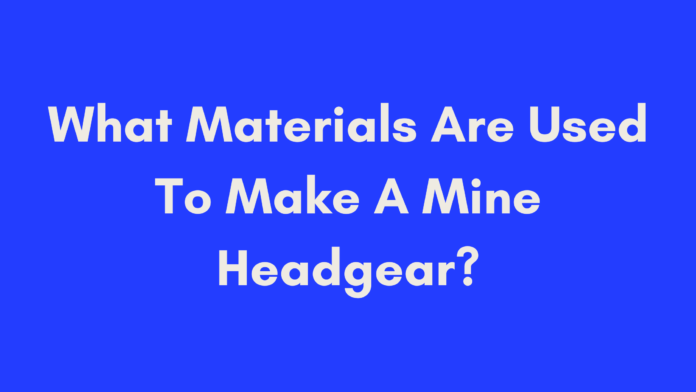Quick Summary
If you’re curious about what materials are used to make mine headgear and why they’re essential, you’re in the right place. Mine headgear, a crucial component in underground mining, relies on a variety of materials to ensure safety, stability, and efficiency.
Steel remains a top choice for its strength and durability, aluminum alloys offer a lighter alternative with good strength, and reinforced concrete enhances stability and soundproofing. Rubber gaskets are vital for waterproofing, while ceramic tiles and plastic coatings provide protective linings. Epoxy resins bind different parts together, and fiberglass offers versatility and corrosion resistance.
Each material plays a specific role in supporting the hoisting systems, protecting miners, and maintaining operational efficiency. Understanding these materials helps in choosing the right components for safe and effective mining operations.
Introduction to Mine Headgear
What is Mine Headgear?
Mine headgear is a critical structural element in underground mining operations. It serves as the central support structure for the hoisting system that transports miners, equipment, and extracted materials up and down the mine shafts. In essence, mine headgear is both a safety feature and an operational necessity.
Historically, mine headgear dates back to early mining practices, where it was essential for supporting the lift and haul systems that allowed miners to access deeper parts of the mine. Over time, the design and materials used in mine headgear have evolved significantly, driven by advancements in engineering and materials science.
Importance of Mine Headgear in Mining Operations
The primary function of mine headgear is to ensure the safe and efficient transport of both personnel and materials. Here’s why it’s indispensable:
- Safety and Structural Support: Mine headgear provides the necessary structural integrity to support the hoisting system, ensuring that it can handle the significant weight of the materials being transported. This includes the weight of heavy mining equipment and extracted ore.
- Role in Material Transport and Access: It facilitates the movement of materials and miners between different levels of the mine. The headgear supports the pulleys and cables that lift and lower the materials, making it possible to access deeper and more remote parts of the mine.
Types of Materials Used in Mine Headgear
Steel: The Traditional Choice
Steel has been the backbone of mine headgear construction for many decades. Its popularity can be attributed to its outstanding strength and durability.
- Benefits: Steel is incredibly strong and can withstand high levels of pressure and stress. This makes it ideal for supporting the heavy loads and dynamic forces experienced in mining operations.
- Historical Use: From Roman aqueducts to modern skyscrapers, steel has a long history of use in structural applications. Its proven track record in these contexts reassures its reliability for mine headgear.
Aluminum Alloys: Strength with Lightness
Aluminum alloys have become increasingly popular in modern mining due to their unique properties.
- Advantages: Aluminum alloys are lighter than steel, which can reduce the overall weight of the headgear and make installation and maintenance easier. Despite their light weight, they still offer considerable strength.
- Comparison with Steel: While steel remains the stronger option, aluminum alloys provide a good balance between strength and weight, making them suitable for applications where weight reduction is critical.
Reinforced Concrete: Enhancing Stability and Soundproofing
Reinforced concrete is another material used in mine headgear, particularly in modern mining operations.
- Applications: It is used to reinforce structural components and improve stability. Its high density also helps in soundproofing, which can create a quieter working environment.
- How It Improves Working Conditions: By reducing noise levels and providing additional support, reinforced concrete helps in maintaining a safer and more comfortable work environment.
Wood Beams: Insulation and Traditional Use
Wood beams might seem outdated compared to steel and concrete, but they still play a role in some mining operations.
- Benefits and Limitations: Wood beams provide natural insulation and are easier to work with in some traditional mining setups. However, they are less durable and more susceptible to degradation from environmental factors.
- Historical and Current Uses: Historically, wood was a common material for headgear. Today, it’s often used in combination with other materials or in mines with specific needs where its properties are advantageous.
Rubber Gaskets: Ensuring Waterproof Seals
Rubber gaskets are crucial for maintaining the integrity of the mine headgear system.
- Function and Importance: They create waterproof seals around various components, preventing water ingress that could damage the headgear or compromise its functionality.
- Types and Applications: Various types of rubber gaskets are used, depending on the specific requirements of the mine headgear and the environmental conditions.
Ceramic Tiles and Plastic Coatings: Protective Linings
Protective linings made from ceramic tiles and plastic coatings are applied to enhance durability and resistance.
- Advantages in Protection: These materials provide a hard, protective layer that guards against wear and tear, chemical exposure, and other damaging factors.
- Examples of Usage: Ceramic tiles are often used in areas with high abrasion, while plastic coatings can be applied to various surfaces for additional protection.
Epoxy Resins: Binding and Structural Integrity
Epoxy resins are used to bind different components of the mine headgear together.
- How Epoxy Resins Are Used: They are applied to bond materials such as wood and metal, ensuring that different parts of the headgear remain securely attached.
- Benefits for Mine Headgear: Epoxy resins enhance the overall structural integrity and durability of the headgear, making it more resilient to environmental stresses.
Fiberglass: Versatility and Modern Applications
Fiberglass offers a modern solution with its versatile properties.
- Benefits of Fiberglass Structures: It’s lightweight yet strong, resistant to corrosion, and can be molded into complex shapes. This makes it ideal for custom-designed mine headgear.
- Comparison with Traditional Materials: Fiberglass provides a modern alternative to traditional materials like steel and concrete, offering benefits in terms of weight and flexibility.
Why These Materials Are Important
Ensuring Safety: Protection Against Hazards
One of the primary roles of mine headgear is to protect miners from various hazards inherent in underground environments. Each material used in mine headgear contributes to safety in different ways:
- Falling Rocks: Steel and reinforced concrete provide robust support to prevent the collapse of shafts and tunnels, reducing the risk of falling rocks that could harm miners.
- Explosive Gases: Materials like rubber gaskets ensure airtight seals, preventing dangerous gases like methane from entering the mine headgear system. This helps to maintain a safe working environment and prevents explosions.
- Impact Resistance: Steel and fiberglass offer high impact resistance, crucial for safeguarding against accidental impacts and equipment failures.
By incorporating these materials, mine headgear can effectively shield miners from numerous risks and ensure a safer work environment.
Enhancing Stability and Structural Support
The stability of mine headgear is crucial, especially in deeper or more complex mining operations. The materials used play a significant role in maintaining structural integrity:
- Support for Hoisting Systems: Steel and reinforced concrete offer the strength needed to support the hoisting systems that transport materials and personnel between different mine levels.
- Resistance to Environmental Stress: Materials such as aluminum alloys and fiberglass provide durability and stability in harsh conditions, including high humidity and varying temperatures.
Effective material choice ensures that the headgear can withstand the stresses of daily operations, including the weight of equipment and the dynamic forces involved in mining.
Improving Ventilation and Working Conditions
Proper ventilation is essential for maintaining a safe and comfortable working environment in mines. Certain materials contribute to improved air quality and ventilation:
- Ventilation Systems: Reinforced concrete and protective coatings help in the installation of ventilation systems by providing the necessary support and protection.
- Reducing Toxic Fumes: Materials like rubber gaskets and epoxy resins prevent the ingress of toxic fumes, ensuring that miners breathe clean air and reducing the risk of respiratory issues.
By using the right materials, mine headgear can enhance overall air quality and create a more conducive working environment.
Long-Term Durability and Maintenance
Durability and ease of maintenance are important factors in the longevity of mine headgear:
- Longevity of Materials: Steel and fiberglass offer long-lasting performance, reducing the need for frequent replacements and repairs.
- Maintenance Tips: Regular inspection and maintenance of materials like rubber gaskets and protective linings can prevent premature wear and extend the life of the headgear.
Choosing durable materials and implementing effective maintenance practices ensure that the mine headgear remains functional and safe over time.
Conclusion
In conclusion, the materials used to make mine headgear play a crucial role in ensuring safety, stability, and efficiency in mining operations. Steel, aluminum alloys, reinforced concrete, wood beams, rubber gaskets, ceramic tiles, epoxy resins, and fiberglass each offer unique benefits that contribute to the overall functionality and safety of mine headgear.
Selecting the right combination of materials is essential for balancing factors like strength, weight, durability, and cost. By prioritizing safety and considering the specific needs of the mining environment, mine headgear can be optimized to protect miners and enhance operational efficiency.
When choosing materials for mine headgear, it’s important to prioritize safety and functionality above all else. The well-being of the workforce and the effectiveness of mining operations depend on the thoughtful selection and use of these materials. If you have any experiences or questions about mine headgear, feel free to share them in the comments or reach out for more information.
Frequently Asked Questions
What are the most common materials used in mine headgear?
The most common materials used in mine headgear include:
- Steel: Known for its strength and durability, steel is the traditional choice for mine headgear construction.
- Aluminum Alloys: These are used for their lightweight properties and good strength-to-weight ratio.
- Reinforced Concrete: Provides additional stability and helps with soundproofing.
- Wood Beams: Historically used for insulation, though less common today.
- Rubber Gaskets: Used to create waterproof seals around components.
- Ceramic Tiles and Plastic Coatings: Offer protective linings to enhance durability.
- Epoxy Resins: Used for binding different materials together.
- Fiberglass: Known for its versatility and resistance to corrosion.
Why is steel preferred for mine headgear?
Steel is preferred for mine headgear because of its exceptional strength and durability. It can handle the high loads and stresses associated with mining operations, making it ideal for supporting the hoisting systems that transport materials and personnel. Its proven reliability in various structural applications also contributes to its widespread use in mine headgear.
How do aluminum alloys compare to steel in mine headgear?
Aluminum alloys are lighter than steel, which can reduce the overall weight of the mine headgear and make installation and maintenance easier. However, steel offers greater strength and impact resistance. The choice between aluminum alloys and steel often depends on the specific requirements of the mining operation, such as weight considerations and load-bearing needs.
What role do rubber gaskets play in mine headgear?
Rubber gaskets are crucial for creating waterproof and airtight seals around various components of the mine headgear. This prevents water and hazardous gases from entering the system, which helps in maintaining safety and ensuring the proper functioning of the headgear.
Why is reinforced concrete used in mine headgear?
Reinforced concrete is used in mine headgear to provide additional stability and support. Its high density also helps in soundproofing, creating a quieter working environment. It is particularly useful in modern mines where enhanced stability and noise reduction are important.
How does fiberglass benefit mine headgear construction?
Fiberglass offers several benefits for mine headgear construction, including its lightweight nature, resistance to corrosion, and ability to be molded into complex shapes. These properties make fiberglass a versatile material that can be used in custom-designed headgear to meet specific operational needs.
What maintenance practices are recommended for materials used in mine headgear?
Regular maintenance practices include:
- Inspecting Steel and Aluminum Components: Look for signs of corrosion, wear, or damage and address them promptly.
- Checking Rubber Gaskets: Ensure that gaskets are intact and replace them if they show signs of degradation.
- Maintaining Protective Linings: Monitor ceramic tiles and plastic coatings for wear and repair or replace as needed.
- Cleaning and Sealing: Regularly clean and reseal any components to maintain their effectiveness and longevity.
Proper maintenance helps in extending the lifespan of the mine headgear and ensuring that it remains safe and functional.
How can I choose the right materials for my mine headgear?
Choosing the right materials involves considering factors such as:
- Operational Requirements: Assess the specific needs of your mining operation, including load-bearing capacity, weight restrictions, and environmental conditions.
- Safety Considerations: Prioritize materials that enhance safety, such as those offering impact resistance and protection against hazardous gases.
- Cost and Durability: Balance the cost of materials with their durability and long-term performance to ensure cost-effectiveness.
Consulting with industry experts and reviewing case studies can also provide valuable insights for making informed decisions about materials.
Source: Quora
Author’s Note
As someone deeply interested in the field of mining and its critical components, I’ve always been fascinated by the intricate balance of safety, efficiency, and innovation in mine headgear design. The materials used in constructing mine headgear are not just technical choices—they are essential to the safety and success of mining operations.
Throughout my research and writing, I’ve drawn on various sources, including industry reports, expert interviews, and firsthand accounts from professionals in the field. Understanding the roles and benefits of different materials has provided me with a deeper appreciation for the complexity involved in mining operations.
I encourage readers to consider the importance of each material discussed and how they contribute to overall safety and efficiency. Whether you’re a mining professional, a student in the field, or simply curious about how mining infrastructure works, I hope this guide offers valuable insights and practical information.
If you have any experiences or additional knowledge to share about mine headgear materials, or if you have any questions, please feel free to leave a comment or reach out. Your feedback and questions are always welcome and contribute to a richer understanding of this vital topic.
Thank you for taking the time to explore this topic with me. Stay safe and informed!

Oliver is a full-time writer with a passion for creating compelling content on diverse topics, including finance, business, product reviews, and more. With a keen eye for detail and a commitment to thorough research, she brings clarity and depth to complex subjects, making them accessible and engaging for readers. Oliver’s dedication to her craft ensures that every article is informative, well-researched, and thought-provoking. Outside of writing, she enjoys exploring new ideas, reading extensively, and continually expanding her knowledge.
Editorial Process
At Trusted Sources, our editorial process is crafted to ensure that every piece of content we produce—whether it’s an informational article or a review—meets the highest standards of accuracy, reliability, and engagement. Our commitment to delivering valuable, research-driven, and reader-centric content is reflected in our systematic and meticulous editorial approach.
Affiliate Disclosure
we are committed to transparency and honesty in all aspects of our operations, including our affiliate partnerships. We participate in various affiliate programs, which means we may earn commissions on qualifying purchases made through links on our Website.


